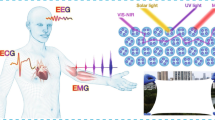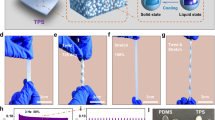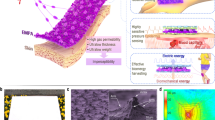Abstract
In hot environments, the human body shows an efficient capability to maintain a stable temperature by benefiting from sweating behavior. Inspired by this skin perspiration strategy, in this study, we demonstrated an innovative polyimide foam (PIF)-based mimetic skin with excellent cooling capability by integrating a silver coating and reusable hydrogel for the first time. Because of the hybrid thermal dissipating system, the successive silver coating quickly transferred heat to the inside of the polyacrylamide hydrogel. Meanwhile, the hydrogel absorbed a large amount of heat due to its large enthalpy and effectively dissipated heat to the environment through the evaporation of moisture, similar to the sweating of skin. Thus, the temperature of the skin-like film was reduced by 25.4°C compared with pure PIF under a high-power laser heating source. Identical and remarkable cooling effects were also obtained in mobile phone and battery applications, far better than commercially available thermally conductive polyimide (PI). This outstanding performance paves a new way for the thermal management application of PI in wearable electronics, microprocessors, and flexible electronics.
Similar content being viewed by others
References
Pu S, Su J, Li L, et al. Bioinspired sweating with temperature sensitive hydrogel to passively dissipate heat from high-end wearable electronics. Energy Convers Manage, 2019, 180: 747–756
Wu N, Ye X, Li J, et al. Passive thermal management systems employing hydrogel for the large-format lithium-ion cell: A systematic study. Energy, 2021, 231: 120946
Pu S, Liao Y, Chen K, et al. Thermogalvanic hydrogel for synchronous evaporative cooling and low-grade heat energy harvesting. Nano Lett, 2020, 20: 3791–3797
Xu S, Cai S, Liu Z. Thermal conductivity of polyacrylamide hydrogels at the nanoscale. ACS Appl Mater Interfaces, 2018, 10: 36352–36360
Haq M A, Su Y, Wang D. Mechanical properties of pnipam based hydrogels: A review. Mater Sci Eng-C, 2017, 70: 842–855
Wang W T, Lu L S, Xie Y X, et al. One-step laser induced conversion of a gelatin-coated polyimide film into graphene: Tunable morphology, surface wettability and microsupercapacitor applications. Sci China Tech Sci, 2020, 64: 1030–1040
Ge G, Zhang Y, Shao J, et al. Stretchable, transparent, and self-patterned hydrogel-based pressure sensor for human motions detection. Adv Funct Mater, 2018, 28: 1802576
Gong P, Wang G, Tran M P, et al. Advanced bimodal polystyrene/multi-walled carbon nanotube nanocomposite foams for thermal insulation. Carbon, 2017, 120: 1–10
Schmidt-Winkel P, Lukens, W W, Yang P, et al. Microemulsion templating of siliceous mesostructured cellular foams with well-defined ultralarge mesopores. Chem Mater, 2000, 12: 686–696
Kenney W L, DeGroot D W, Alexander Holowatz L. Extremes of human heat tolerance: Life at the precipice of thermoregulatory failure. J Thermal Biol, 2004, 29: 479–485
Ma S, Wang C, Cong B, et al. Anisotropic all-aromatic polyimide aerogels with robust and high-temperature stable properties for flexible thermal protection. Chem Eng J, 2022, 431: 134047
Gao Q, Pan Y, Zheng G, et al. Flexible multilayered MXene/thermoplastic polyurethane films with excellent electromagnetic interference shielding, thermal conductivity, and management performances. Adv Compos Hybrid Mater, 2021, 4: 274–285
Ma T, Zhao Y, Ruan K, et al. Highly thermal conductivities, excellent mechanical robustness and flexibility, and outstanding thermal stabilities of aramid nanofiber composite papers with nacre-mimetic layered structures. ACS Appl Mater Interfaces, 2020, 12: 1677–1686
Shen X, Zheng Q, Kim J K. Rational design of two-dimensional nanofillers for polymer nanocomposites toward multifunctional applications. Prog Mater Sci, 2021, 115: 100708
Huang Y, Ouyang Q, Guo Q, et al. Graphite film/aluminum laminate composites with ultrahigh thermal conductivity for thermal management applications. Mater Des, 2016, 90: 508–515
Song N, Cao D, Luo X, et al. Highly thermally conductive polypropylene/graphene composites for thermal management. Compos Part A-Appl Sci Manuf, 2020, 135: 105912
Yu A M, Li Q. Studies on preparation and thermal control behavior of hybrid fillers/binary-polymer composites with positive temperature coefficient characteristic. Sci China Tech Sci, 2021, 64: 1447–1458
An L, Yang Z, Zeng X, et al. Flexible and quasi-isotropically thermoconductive polyimide films by guided assembly of boron nitride nanoplate/boron nitride flakes for microelectronic application. Chem Eng J, 2022, 431: 133740
Barthwal M, Dhar A, Powar S. Effect of nanomaterial inclusion in phase change materials for improving the thermal performance of heat storage: A review. ACS Appl Energy Mater, 2021, 4: 7462–7480
Ye Q, Tao P, Chang C, et al. Form-stable solar thermal heat packs prepared by impregnating phase-changing materials within carbon-coated copper foams. ACS Appl Mater Interfaces, 2019, 11: 3417–3427
Liu Z, Hu Q, Guo S, et al. Thermoregulating separators based on phase-change materials for safe lithium-ion batteries. Adv Mater, 2021, 33: 2008088
Wu Q, Pan L, Wang H, et al. A green and scalable method for producing high-performance polyimide aerogels using low-boiling-point solvents and sublimation drying. Polym J, 2015, 48: 169–175
Zhang Z, Deng Y, Lun Z, et al. Mechanically strong and tailorable polyimide aerogels prepared with novel silicone polymer crosslinkers. Gels, 2022, 8: 57
Chen K, Guo L J, Wang H. A review on thermal application of metal foam. Sci China Tech Sci, 2020, 63: 2469–2490
Peng Y, Zhou J, Yang Y, et al. An integrated 3D hydrophilicity/hydrophobicity design for artificial sweating skin (i-TRANS) mimicking human body perspiration. Adv Mater, 2022, 34: 2204168
Guo Y, Guan W, Lei C, et al. Scalable super hygroscopic polymer films for sustainable moisture harvesting in arid environments. Nat Commun, 2022, 13: 2761
Chen S, Cao Y, Feng J. Polydopamine as an efficient and robust platform to functionalize carbon fiber for high-performance polymer composites. ACS Appl Mater Interfaces, 2014, 6: 349–356
Li Q, Liu S, Guo Y, et al. Mussel-inspired polydopamine-enhanced polyimide for ultrahigh toughness and ultraviolet shielding applications. ACS Appl Polym Mater, 2021, 3: 896–907
Shen Z C, Ding Y G, Wang Y Z, et al. Comparison of damage mechanism of polyimide films in space radiation environments. J Phys-Conf Ser, 2021, 1765: 012024
Yang D, Ni Y, Kong X, et al. Mussel-inspired modification of boron nitride for natural rubber composites with high thermal conductivity and low dielectric constant. Compos Sci Tech, 2019, 177: 18–25
Mao Y, Zhu M, Wang W, et al. Well-defined silver conductive pattern fabricated on polyester fabric by screen printing a dopamine surface modifier followed by electroless plating. Soft Matter, 2018, 14: 1260–1269
Meschi Amoli B, Trinidad J, Hu A, et al. Highly electrically conductive adhesives using silver nanoparticle (Ag NP)-decorated graphene: The effect of nps sintering on the electrical conductivity improvement. J Mater Sci-Mater Electron, 2014, 26: 590–600
Guo Y, Yang X, Ruan K, et al. Reduced graphene oxide heterostructured silver nanoparticles significantly enhanced thermal conductivities in hot-pressed electrospun polyimide nanocomposites. ACS Appl Mater Interfaces, 2019, 11: 25465–25473
Xiang J, Zhou G, Hong Y, et al. Direct additive copper plating on polyimide surface with silver ammonia via plasma modification. Appl Surf Sci, 2022, 587: 152848
Zhang Y, Li C, Yang H, et al. A flexible organohydrogel-based humidity sensor for noncontact artificial sensation. Sci China Tech Sci, 2021, 65: 191–200
Pu S, Fu J, Liao Y, et al. Promoting energy efficiency via a self-adaptive evaporative cooling hydrogel. Adv Mater, 2020, 32: 1907307
Zhang X, Ni X, Li C, et al. Co-gel strategy for preparing hierarchically porous silica/polyimide nanocomposite aerogel with thermal insulation and flame retardancy. J Mater Chem A, 2020, 8: 9701–9712
Xu X, Liu Y, Fu W, et al. Poly(n-isopropylacrylamide)-based thermoresponsive composite hydrogels for biomedical applications. Polymers, 2020, 12: 580
Huang Y, Tang Y, Yuan W, et al. Challenges and recent progress in thermal management with heat pipes for lithium-ion power batteries in electric vehicles. Sci China Tech Sci, 2021, 64: 919–956
Meng X, Yu H, Wang L, et al. Recent progress on fabrication and performance of polymer composites with highly thermal conductivity. Macromol Mater Eng, 2021, 306: 2100434
Author information
Authors and Affiliations
Corresponding authors
Additional information
This work was supported by the National Natural Science Foundation of China (Grant No. U21A2094), CASHIPS Director’s Fund (Grant Nos. YZJJZX202015, YZJJ202304-CX, and YZJJ2023QN36), and the Anhui Province Postdoctoral Researcher Research Project (Grant No. E24F0D27).
Supporting Information
The supporting information is available online at https://tech.scichina.com and https://link.springer.com. The supporting materials are published as submitted, without typesetting or editing. The responsibility for scientific accuracy and content remains entirely with the authors.
Electronic supplementary material
Rights and permissions
About this article
Cite this article
Jiang, M., Xiao, C., He, X. et al. Skin mimicking-sweating evaporation polyimide cooling film for electronic devices. Sci. China Technol. Sci. 66, 2797–2807 (2023). https://doi.org/10.1007/s11431-023-2374-0
Received:
Accepted:
Published:
Issue Date:
DOI: https://doi.org/10.1007/s11431-023-2374-0




